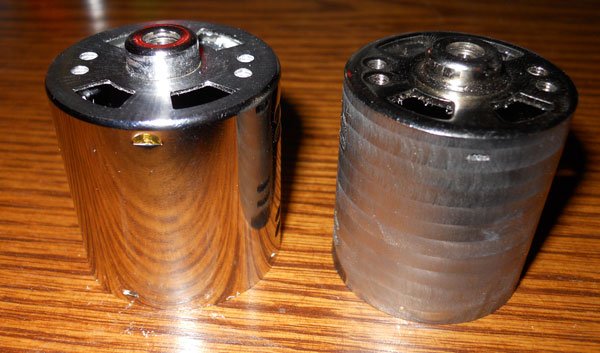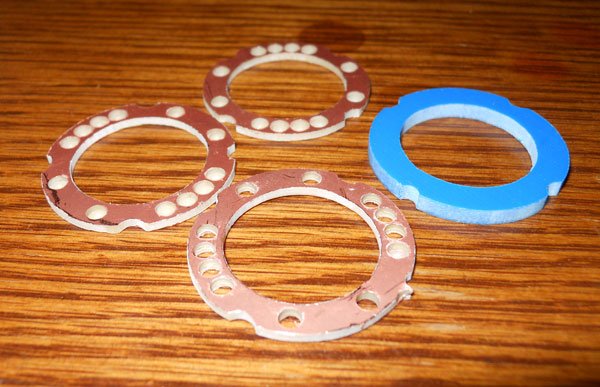Some progress! I've had people bugging me for light weight motors for a long while, and never had the time or resources to get it done proper. As a first stop for quick and cheap modifications, I pulled out old CAD files I made for modding 540s. Here are two simple ones without heatsinking, I have some "cool" designs done too.
Mod 1, face the motor. Good for easy 5 or 6 grams without reducing motor efficiency and torque. Mod 2, thin the can radius. This particular path takes about 18 grams from the motor. The magnets lose about 10% flux on the work side, and lose 8% flux out the back side. People running very small (500mah) packs will have to bump up to the next biggest size. Reduce your motor weight so you can add it back on a higher battery pack? Some people want it, so I'll provide. Its good fun while I get ready for the next project anyway.
Doing a full tilt weight savings we can hit 36 grams removed before touching the rotor. Going from a TorqueMaster to a Crawlmaster arm loses another 8 grams,, and further lightening is possible. Not my cup of tea for motor design, but when I have the ANSWER on the perfect motor I won't be selling toy motors :ror: Hopefully that day never comes and I can keep learning until I'm pushing up daisies.
Next up is a router attachment and a fogbuster cooling system. I overheated a very expensive bit yesterday when I took the vac system off for a few minutes. It was doing a lot of cooling evidently! I also found an old router (its like a super sized dremel) that will give me 20k and 30k spindle speeds, and shall mount up to the head nicely. Great for PCB work!
I'll end with some quotes that help me keep the thirst for knowledge. Motor design and power electronics really mesh well with these ideals.
“Every person that you meet knows something you don't; learn from them.”
― H. Jackson Brown Jr.
“We are all apprentices in a craft where no one ever becomes a master.”
― Ernest Hemingway
“Be careful not to mistake insecurity and inadequacy for humility! Humility has nothing to do with the insecure and inadequate! Just like arrogance has nothing to do with greatness!”
― C. JoyBell C.
On to the next, we are done with this project. Pardon the dirty motors, these are just practice.
Mod 1, face the motor. Good for easy 5 or 6 grams without reducing motor efficiency and torque. Mod 2, thin the can radius. This particular path takes about 18 grams from the motor. The magnets lose about 10% flux on the work side, and lose 8% flux out the back side. People running very small (500mah) packs will have to bump up to the next biggest size. Reduce your motor weight so you can add it back on a higher battery pack? Some people want it, so I'll provide. Its good fun while I get ready for the next project anyway.
Doing a full tilt weight savings we can hit 36 grams removed before touching the rotor. Going from a TorqueMaster to a Crawlmaster arm loses another 8 grams,, and further lightening is possible. Not my cup of tea for motor design, but when I have the ANSWER on the perfect motor I won't be selling toy motors :ror: Hopefully that day never comes and I can keep learning until I'm pushing up daisies.
Next up is a router attachment and a fogbuster cooling system. I overheated a very expensive bit yesterday when I took the vac system off for a few minutes. It was doing a lot of cooling evidently! I also found an old router (its like a super sized dremel) that will give me 20k and 30k spindle speeds, and shall mount up to the head nicely. Great for PCB work!
I'll end with some quotes that help me keep the thirst for knowledge. Motor design and power electronics really mesh well with these ideals.
“Every person that you meet knows something you don't; learn from them.”
― H. Jackson Brown Jr.
“We are all apprentices in a craft where no one ever becomes a master.”
― Ernest Hemingway
“Be careful not to mistake insecurity and inadequacy for humility! Humility has nothing to do with the insecure and inadequate! Just like arrogance has nothing to do with greatness!”
― C. JoyBell C.
On to the next, we are done with this project. Pardon the dirty motors, these are just practice.
Attachments
Last edited:



